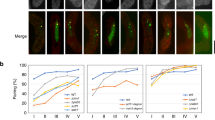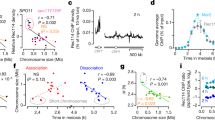Abstract
Caenorhabditis elegans chromosomes contain specialized regions called pairing centres, which mediate homologous pairing and synapsis during meiosis. Four related proteins, ZIM-1, 2, 3 and HIM-8, associate with these sites and are required for their essential functions. Here we show that short sequence elements enriched in the corresponding chromosome regions selectively recruit these proteins in vivo. In vitro analysis using SELEX indicates that the binding specificity of each protein arises from a combination of two zinc fingers and an adjacent domain. Insertion of a cluster of recruiting motifs into a chromosome lacking its endogenous pairing centre is sufficient to restore homologous pairing, synapsis, crossover recombination and segregation. These findings help to illuminate how chromosome sites mediate essential aspects of meiotic chromosome dynamics.
This is a preview of subscription content, access via your institution
Access options
Subscribe to this journal
Receive 12 print issues and online access
$209.00 per year
only $17.42 per issue
Buy this article
- Purchase on Springer Link
- Instant access to full article PDF
Prices may be subject to local taxes which are calculated during checkout






Similar content being viewed by others
References
McKim, K. S., Howell, A. M. & Rose, A. M. The effects of translocations on recombination frequency in Caenorhabditis elegans. Genetics 120, 987–1001 (1988).
McKim, K. S., Peters, K. & Rose, A. M. Two types of sites required for meiotic chromosome pairing in Caenorhabditis elegans. Genetics 134, 749–768 (1993).
Villeneuve, A. M. A cis-acting locus that promotes crossing over between X chromosomes in Caenorhabditis elegans. Genetics 136, 887–902 (1994).
Zetka, M. & Rose, A. The genetics of meiosis in Caenorhabditis elegans. Trends Genet. 11, 27–31 (1995).
Zetka, M. C. & Rose, A. M. The meiotic behavior of an inversion in Caenorhabditis elegans. Genetics 131, 321–332 (1992).
MacQueen, A. J., Colaiacovo, M. P., McDonald, K. & Villeneuve, A. M. Synapsis-dependent and -independent mechanisms stabilize homolog pairing during meiotic prophase in C. elegans. Genes Dev. 16, 2428–2442 (2002).
MacQueen, A. J. et al. Chromosome sites play dual roles to establish homologous synapsis during meiosis in C. elegans. Cell 123, 1037–1050 (2005).
Phillips, C. M. & Dernburg, A. F. A family of zinc-finger proteins is required for chromosome-specific pairing and synapsis during meiosis in C. elegans. Dev. Cell 11, 817–829 (2006).
Phillips, C. M. et al. HIM-8 binds to the X chromosome pairing center and mediates chromosome-specific meiotic synapsis. Cell 123, 1051–1063 (2005).
Herman, R. K. & Kari, C. K. Recombination between small X chromosome duplications and the X chromosome in Caenorhabditis elegans. Genetics 121, 723–737 (1989).
Hodgkin, J., Horvitz, H. R. & Brenner, S. Nondisjunction mutants of the nematode Caenorhabditis elegans. Genetics 91, 67–94 (1979).
Swan, K. A. et al. High-throughput gene mapping in Caenorhabditis elegans. Genome Res. 12, 1100–1105 (2002).
Wicks, S. R., Yeh, R. T., Gish, W. R., Waterston, R. H. & Plasterk, R. H. Rapid gene mapping in Caenorhabditis elegans using a high density polymorphism map. Nature Genet. 28, 160–164 (2001).
Nicoll, M., Akerib, C. C. & Meyer, B. J. X-chromosome-counting mechanisms that determine nematode sex. Nature 388, 200–204 (1997).
Mello, C. C., Kramer, J. M., Stinchcomb, D. & Ambros, V. Efficient gene transfer in C.elegans: extrachromosomal maintenance and integration of transforming sequences. EMBO J. 10, 3959–3970 (1991).
Kelly, W. G. et al. X-chromosome silencing in the germline of C. elegans. Development 129, 479–492 (2002).
Dawes, H. E. et al. Dosage compensation proteins targeted to X chromosomes by a determinant of hermaphrodite fate. Science 284, 1800–1804 (1999).
McDonel, P., Jans, J., Peterson, B. K. & Meyer, B. J. Clustered DNA motifs mark X chromosomes for repression by a dosage compensation complex. Nature 444, 614–618 (2006).
Sanford, C. & Perry, M. D. Asymmetrically distributed oligonucleotide repeats in the Caenorhabditis elegans genome sequence that map to regions important for meiotic chromosome segregation. Nucleic Acids Res. 29, 2920–2926 (2001).
Miller, J., McLachlan, A. D. & Klug, A. Repetitive zinc-binding domains in the protein transcription factor IIIA from Xenopus oocytes. EMBO J. 4, 1609–1614 (1985).
Tupler, R., Perini, G. & Green, M. R. Expressing the human genome. Nature 409, 832–833 (2001).
Pavletich, N. P. & Pabo, C. O. Zinc finger-DNA recognition: crystal structure of a Zif268-DNA complex at 2.1 A. Science 252, 809–817 (1991).
Kadonaga, J. T., Carner, K. R., Masiarz, F. R. & Tjian, R. Isolation of cDNA encoding transcription factor Sp1 and functional analysis of the DNA binding domain. Cell 51, 1079–1090 (1987).
Perez, E. E. et al. Establishment of HIV-1 resistance in CD4(+) T cells by genome editing using zinc-finger nucleases. Nature Biotech. 26, 808–816 (2008).
Malone, C. J. et al. The C. elegans hook protein, ZYG-12, mediates the essential attachment between the centrosome and nucleus. Cell 115, 825–836 (2003).
Penkner, A. et al. The nuclear envelope protein Matefin/SUN-1 is required for homologous pairing in C. elegans meiosis. Dev. Cell 12, 873–885 (2007).
Colaiacovo, M. P. et al. Synaptonemal complex assembly in C. elegans is dispensable for loading strand-exchange proteins but critical for proper completion of recombination. Dev. Cell 5, 463–474 (2003).
Dernburg, A. F. et al. Meiotic recombination in C. elegans initiates by a conserved mechanism and is dispensable for homologous chromosome synapsis. Cell 94, 387–398 (1998).
Kamath, R. S. & Ahringer, J. Genome-wide RNAi screening in Caenorhabditis elegans. Methods 30, 313–321 (2003).
Bailey, T. L. & Elkan, C. Fitting a mixture model by expectation maximization to discover motifs in biopolymers. Proc. Int. Conf. Intell. Syst. Mol. Biol. 2, 28–36 (1994).
Acknowledgements
This work was supported by an NSF Predoctoral Fellowship (C.M.P.) and by Burroughs Wellcome Career Award 1000950 and NIH R01 GM065591 (A.F.D.). We are grateful to Anne Villeneuve for SYP-1 antibodies, Barbara Meyer, Kevin Corbett and Ed Rebar for valuable suggestions, to members of the Meyer lab for assistance with the extrachromosomal array assay and to members of the Dernburg lab and anonymous referees for helpful comments on the manuscript.
Author information
Authors and Affiliations
Contributions
C.M.P. and A.F.D. designed most experiments and wrote the manuscript. J.H.C. provided cDNA clones for the SELEX assays, which were executed by X.M. and L.Z. with guidance from F.D.U. All other experiments were performed by C.M.P.
Corresponding author
Ethics declarations
Competing interests
The authors declare no competing financial interests.
Supplementary information
Supplementary Information
Supplementary Information (PDF 1558 kb)
Rights and permissions
About this article
Cite this article
Phillips, C., Meng, X., Zhang, L. et al. Identification of chromosome sequence motifs that mediate meiotic pairing and synapsis in C. elegans. Nat Cell Biol 11, 934–942 (2009). https://doi.org/10.1038/ncb1904
Received:
Accepted:
Published:
Issue Date:
DOI: https://doi.org/10.1038/ncb1904
This article is cited by
-
Time to match; when do homologous chromosomes become closer?
Chromosoma (2022)
-
The TERB1-TERB2-MAJIN complex of mouse meiotic telomeres dates back to the common ancestor of metazoans
BMC Evolutionary Biology (2020)
-
Help or hindrance: how do microtubule-based forces contribute to genome damage and repair?
Current Genetics (2020)
-
Meiotic chromosomes in motion: a perspective from Mus musculus and Caenorhabditis elegans
Chromosoma (2019)
-
Leagues of their own: sexually dimorphic features of meiotic prophase I
Chromosoma (2019)



